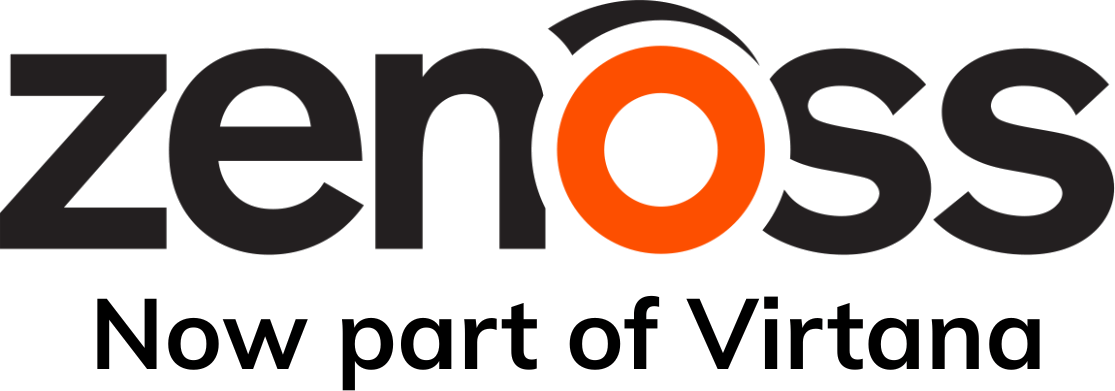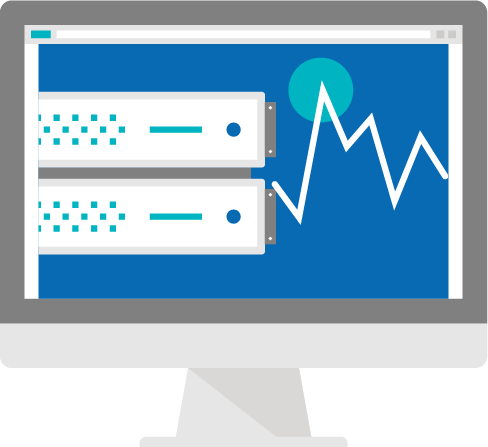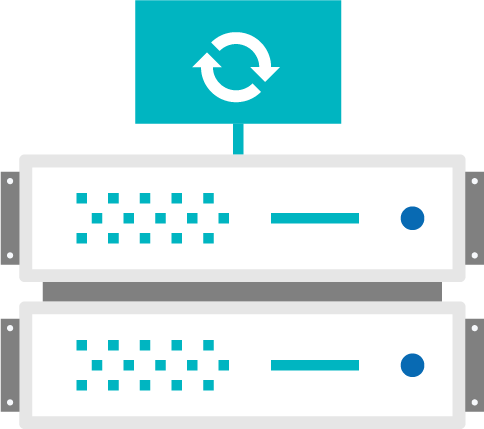Improve Storage Performance With Comprehensive Analysis
Zenoss enables you to break free of the traditional siloed monitoring approach to storage, providing a unified monitoring tool that models your storage infrastructure as part of an end-to-end IT service view. Not only does Zenoss offer increased visibility into your storage infrastructure, it also delivers performance metrics and availability data that correlates across the entire IT service chain — mapping all components and dependencies.
Monitor Multivendor Storage Infrastructures From a Unified View
Zenoss monitors the most trusted storage technologies from vendors like EMC, Dell, NetApp and many more. With support across your entire vendor network, Zenoss allows you to seamlessly monitor all physical, virtual and cloud storage resources from a single view.
You get visibility into how your physical disk storage array, network-attached storage systems, storage area networks, file systems, and other components are functioning in the context of overall service delivery. Built from the ground up to deal with dynamic environments, Zenoss provides monitoring and analytics for traditional cloud and hybrid IT infrastructures.
With Zenoss storage monitoring software, you can:
- Discover disks, storage system enclosures, RAID groups, aggregates, LUNs, power supplies and other key components.
- Monitor storage capacity, throughput, space utilization, cache efficiency, power consumption, directory size, disk usage, file count, RAID array status and temperature.
- Collect every storage performance issue and event and forward them to the Zenoss console.
- Map service impact relationships between storage components and the rest of the infrastructure.
- Report on usage and plan for future storage capacity needs.
BREAKING THE IRON TRIANGLE OF STORAGE
 Optimize Storage Utilization With Zenoss Monitoring
Optimize Storage Utilization With Zenoss Monitoring
Zenoss eliminates the complexity and overhead of disparate monitoring tools for each different storage system, providing in-depth multivendor monitoring that allows you to maximize the utilization of storage resources. This increase in overall visibility enables you to map utilization over time for simplified capacity planning, driving immense cost savings in large enterprise and service provider environments.
An Overview of Storage Monitoring Software
Data storage is an essential component in modern IT environments — whether you're using a physical data center, cloud environments or a combination of the two. However, storage is only one piece of the puzzle.
To effectively manage your data storage environment, including all resources, software and hardware components, IT teams need a comprehensive storage performance monitoring solution that covers every part of your infrastructure. This is especially true when a single performance issue can lead to delays and downtime that hurt your end-user experience.
Monitoring software like Zenoss provides a critical view into the overall health and capacity of not just your cloud storage but also your broader IT infrastructure. This enables you to answer key questions, such as:
- Is the storage area network performance enough to keep up?
- Does each storage device have enough resources to operate?
- Has any data been lost due to network congestion or errors?
- Is a given storage system approaching maximum capacity?
- Can you determine the root cause and implement a solution should any storage performance issue arise?
With infrastructure and storage performance monitoring software from Zenoss, you can automatically track things like performance metrics, storage capacity, availability and the overall health of each storage device — whether physical or virtual — all from a single dashboard.
What Effective Storage Performance Monitoring Can Do for Your Organization
Storage performance monitoring automatically alerts you whenever there's a slowdown or issue. With real-time visibility and the capability to track performance metrics across all storage arrays, you can diagnose and resolve problems faster and more accurately.
As you analyze these trends over time, you can leverage this information to proactively refine performance. Not only does this increase storage resource efficiency, but it also improves the overall experience for your end users.
However, before you begin to optimize your storage management tools and processes, it's important to understand the key metrics and best practices for monitoring data storage.
Critical KPIs to Track
Your storage monitoring tool should have the capabilities to monitor key performance metrics, including:
- Storage Capacity: Available capacity is a metric that allows you to track storage resources by measuring the space available on a given storage device. While there isn't a standard for the right amount of free space, a general rule of thumb is to upgrade your storage area network (SAN) once you exceed 80% capacity.
- CPU Utilization: CPU utilization measures how much time your systems spend processing and completing storage requests. You may begin to experience storage performance issues under 50% utilization. If you surpass 50% for a short period of time, there is likely a problem, and you'll need to identify the root cause as soon as possible. You can do this by troubleshooting components inside or outside of your storage environment.
- Latency: Latency tracks the response time (generally in milliseconds) of each storage device while processing requests, such as reading data or writing it to a physical disk. High latency is likely due to fragmented data, large files or times when you're accessing a large volume of records.
- Throughput: Throughput is a similar metric to latency, only it measures the number of bytes a storage device reads or writes each second, rather than the time it takes. While your throughput rate will change based on the demand for data transfers, the overall goal is to ensure your devices aren't regularly stressed by large storage traffic.
- Input/Output Operations Per Second (IOPS): Whereas latency measures processing time and throughput measures byte size, IOPS monitors the number of transfers, reads and writes (i.e., inputs and outputs) that each device achieves per second. A stable or degrading IOPS metric could indicate underlying problems in your storage infrastructure that need to be addressed.
- Queue Depth: In contrast to IOPS, the queue depth of a device monitors the number of pending input and output requests. While some level of queueing is normal, a sudden jump in the queue depth may indicate you need to investigate possible performance problems. Queue depth is also related to latency, as high depth and low latency could indicate problems in your storage environment.
Best Practices for Storage Monitoring
When it comes to monitoring your storage performance, it's not as simple as setting up a tool to do everything for you. An effective storage management strategy requires you to implement a monitoring solution that provides actionable insights, but driving meaningful results is up to each organization.
To help you optimize your storage management process, here is our list of four best practices to follow:
1. Unify Your View on a Centralized Dashboard
A common challenge in effective storage management has been the time and effort it takes to actively monitor storage systems and their operations. By integrating a unified storage monitoring tool into your management suite, you can centralize all of your data on a single dashboard. With this comprehensive visibility all in one place, you get a holistic view of your entire storage environment, including key metrics like device performance and capacity, alongside views of your networking, servers and all other infrastructure.
2. Understand Your Current Storage Traffic and Data Usage Patterns
Once you’ve unified your view, it’s important to determine how your organization currently uses and stores data. For instance, do you experience periods of high storage traffic during specific times of the year, like holidays? Do you primarily read, write and transfer small files or volumes of data? Using performance monitoring and analysis to answer these questions can help you identify ways to improve your storage architecture.
3. Optimize Your Storage Systems and Devices
A unified approach to storage monitoring offers more than just reports and analysis. With a detailed view of system metrics, you get actionable insights that can help you better optimize your architecture for balanced workloads. For example, if a cloud service has low I/O requirements, moving it to a lower-performing storage system can help you free up capacity in systems with better performance.
4. Forecast Future Storage Trends
By monitoring and analyzing your storage performance metrics over time, you can not only make immediate improvements to your environment, but predict future trends as well. Use your monitoring solution to highlight degraded performance and prevent potential device failures. You can even plan for future capacity expansions to ensure your organization continues running smoothly now and in the future.
Optimize Your Storage Infrastructure Performance With Zenoss
With real-time storage performance monitoring from Zenoss, you get 360-degree visibility into your hybrid IT ecosystem to eliminate data silos, reduce complexity and gain vital insights into your systems performance. View our supported storage monitoring technologies below to see how Zenoss can integrate with your current systems.

Monitor Dell EMC Resources

Monitor NetApp Resources

Monitor OpenStack Resources
Enabling IT to Move at the Speed of Business
Zenoss is built for modern IT infrastructures. Let's discuss how we can work together.
Schedule a Demo
Want to see us in action? Schedule a demo today.




 Optimize Storage Utilization With Zenoss Monitoring
Optimize Storage Utilization With Zenoss Monitoring